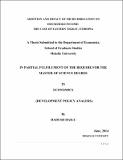| dc.description.abstract | Micro irrigation is one of the most useful irrigation systems designed to increase production and productivity. Planners, researchers, development practitioners, and donors emphasized the importance of micro irrigation in their policy recommendations and actual measures. This study focuses on the adoption and impact of micro irrigation with specific reference to Eastern Tigray. Studies focusing on the impact of micro irrigation are scanty in the study area. The main objective of the study is to investigate the factors determine the adoption and impact of micro irrigation on the income of rural households. Analysis was based on quantitative and qualitative data. Quantitative data have been gathered from primary sources, using semi- structured questionnaire, from 388 randomly selected households (179 micro irrigation users and 209 non users). Secondary data were also collected from different sources. The simplest way to estimate the effect of treatment would be to obtain the difference between the outcome of micro irrigation users and non-users of MI. This would be valid if the participants of the program were randomly selected. However in reality this is unlikely to be the case. Problems associated with self-selection will result in biased estimates. Hence, the study used Propensity Score matching method to obtain unbiased estimates. Moreover, descriptive statistics (ANOVA, Chi square and mean) was also employed for analysis to achieve the research objectives. Findings of the study show that lack of awareness, sufficient irrigation water and the presences of pest and disease are the major problems incounterd in micro irrigation participation and the main household characterstic that enfulence adoption of this technology are gender of the household head, age, family size, non-farm participation, availability of water for irrigation, extension service, the frequency of the development agent visit, and market distance and in general micro irrigation have brought a significant positive impact on income of its users. | en_GB |


